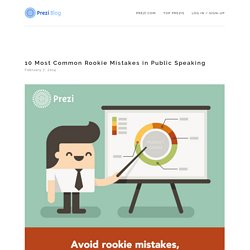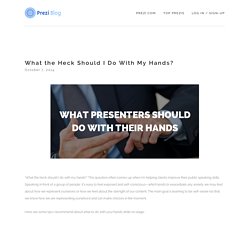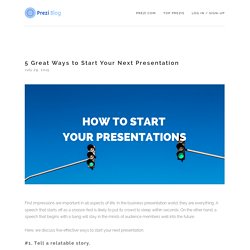

Visual Storytelling: Creating More Persuasive Presentations. Your project in this class is to develop a presentation using a visual story or metaphor to bring your core messages to life.

Use your Project Workspace as an ongoing place to bounce ideas, ask questions, and show your progress towards the final piece. Personally, I always find it helpful to set myself a schedule — commit to uploading your idea today, your sketches next week, and your final presentation in 14 days. Remember: The more you share your thinking, the easier it is for fellow students to offer constructive, useful feedback! Presentation topicAudience research2-3 core messagesVisual metaphorRough presentation structure (sketches, thumbnails)Final presentation FAQs What software do I need? You're welcome to use Prezi or another tool of your choosing. What is my theme? Presentation Tips: How to Create a Powerful Story. The best presenters are not presenters at all; they are storytellers.

These are the people who capture your attention as they say their first sentence and hold it for the entirety of their time on stage. These are the people with whom you feel a connection after hearing their story and whom you are compelled to approach to work with in the future. How can you be one of those people? Here, we break down a few ways to craft a powerful story for your next presentation. Make it real. Personal, genuine stories that reveal vulnerability are the most gripping.
Try not to worry about revealing too much about yourself. Start with the objective. Design your first few sentences to grab audience members straight away. Not sure how to start? Focus on one or two points. We’ve all been to dinner parties where one person dominates the group’s conversation with a series of rambling, never-ending stories. 10 Most Common Rookie Mistakes in Public Speaking. Don't make these rookie mistakes—learn how to give great presentations and become a better presenter.

In this guest post, Terry Gault, Managing Partner and Vice President of The Henderson Group, provides insight into how to become a better presenter by avoiding a few common mistakes. Terry oversees all curriculum and services at The Henderson Group. In addition he is responsible for the selection, training and development of all trainers and facilitators for The Henderson Group, and has been an instructor with the Henderson Group for over 15 years. Having coached clients on presentation skills since 1997, I’ve noticed some clear patterns in the behavior of inexperienced presenters. Take a look at the prezi we've made to illustrate these 10 mistakes, and the easy ways that you can avoid them. Brene Brown: The power of vulnerability.
What the Heck Should I Do With My Hands? Some presenters hold their hands in the “prayer” or “professor” position.

This always seems either awkward or pretentious to me. Others clasp their hands in front of them. Another common phenomenon is what I call “T-Rex Arms.” In this case, the speaker is gesturing, but their elbows don’t leave their sides. This makes them seem stiff and constrained rather than free and open. Any closed posture projects the need to protect one’s self. 3. Some speakers have fidgety hands, which makes them look nervous and unsure of themselves. The fundamental truth I learned in my acting training is that our emotions are driven by our actions.
Incorporating these behaviors into your practice will drive that result—more confidence and power. Terry Gault is Managing Partner and Vice President of The Henderson Group, provides insight into how to become a better presenter by avoiding a few common mistakes. Last Words: 5 Effective Ways to Close Your Next Presentation.
Think back to the last time you attended a really fun concert.

The band most likely played an awesome set, but the ending was what you loved most. That was when the greatest hits came out, the fireworks started exploding overhead, and the crowd went wild. You left on a high, with great memories. What you remember best from that experience is most likely the ending. Presentations are no different. So, what are some of the best ways to close out your next presentation if you want to end with a bang? Need help getting started with your talk? #1. Steve Jobs was famous for ending his speeches with the phrase, “one more thing,” then saying something startling that everyone would be talking about once they left the auditorium. 5 Great Ways to Start Your Next Presentation. First impressions are important in all aspects of life.

In the business presentation world, they are everything. A speech that starts off as a snooze-fest is likely to put its crowd to sleep within seconds. On the other hand, a speech that begins with a bang will stay in the minds of audience members well into the future. Here, we discuss five effective ways to start your next presentation. #1. Skip the “thank yous” and the self-introductions (I am a graduate of… I am the CEO of…).